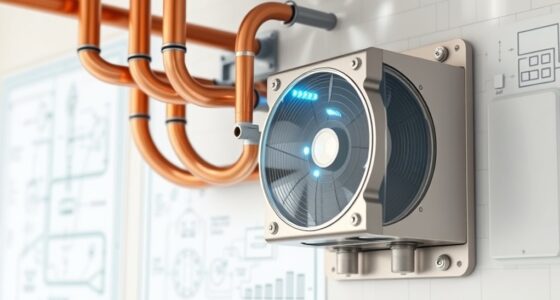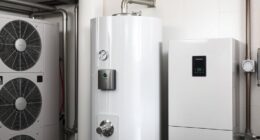The vapor compression refrigeration cycle involves refrigerant moving through key components to cool effectively. You start with the refrigerant in the evaporator, absorbing heat and turning into vapor. This vapor is compressed, increasing its pressure and temperature, then flows to the condenser, where it releases heat and becomes liquid. An expansion valve then reduces its pressure before it re-enters the evaporator. Understanding each part helps you grasp how cooling systems work—continue exploring to learn more.
Key Takeaways
- The cycle involves compressing, condensing, expanding, and evaporating refrigerant to transfer heat effectively.
- The compressor increases refrigerant pressure and temperature, facilitating heat transfer in subsequent stages.
- The condenser releases absorbed heat, converting high-pressure vapor into liquid refrigerant.
- The expansion valve reduces refrigerant pressure, enabling efficient heat absorption in the evaporator.
- The cycle repeats continuously to maintain cooling or refrigeration through phase changes of the refrigerant.
Key Components of the Cycle

The vapor compression refrigeration cycle relies on four main components working together to transfer heat efficiently. These are the compressor, condenser, expansion valve, and evaporator. The refrigerant’s properties are essential because they determine how well it absorbs and releases heat, directly affecting cycle efficiency. The compressor pressurizes the refrigerant, increasing its temperature and pressure. It then moves to the condenser, where it releases heat to the surroundings and condenses into a liquid. The expansion valve reduces the refrigerant’s pressure, preparing it for absorption of heat in the evaporator. In the evaporator, the refrigerant absorbs heat, cooling the environment. Understanding these key components and refrigerant properties helps optimize system performance and guarantee efficient heat transfer throughout the cycle.
The Refrigeration Cycle Process

Understanding how the main components work together helps clarify the step-by-step process of the refrigeration cycle. You start with the refrigerant in the evaporator, where it absorbs heat, changing from low-pressure liquid to vapor—this is the first stage. The vapor then moves to the compressor, which increases its pressure and temperature, following thermodynamic principles. Next, the high-pressure vapor flows through the condenser, releasing heat and condensing into a high-pressure liquid. This liquid passes through an expansion device, where pressure drops suddenly, cooling it further. Finally, the low-pressure refrigerant returns to the evaporator, and the cycle repeats. Recognizing these stages helps you understand how energy is transferred efficiently, driven by thermodynamic principles, to achieve effective refrigeration. Additionally, the headphone jack types and their compatibility are essential when setting up audio devices, ensuring proper connection and functionality.
Role of the Compressor

The compressor plays a essential role in the vapor compression refrigeration cycle by increasing the pressure and temperature of the refrigerant vapor. This compression process enables the refrigerant to release heat later in the cycle, making cooling possible. Your choice of compressor type—reciprocating, rotary, or scroll—affects system performance and efficiency. Compressor efficiency is fundamental because it impacts energy consumption and overall system operation. A highly efficient compressor minimizes power use while maintaining the necessary pressure rise. As the heart of the cycle, the compressor guarantees continuous flow and proper pressure levels, directly influencing cooling capacity. Proper maintenance and selection of the right compressor type enhance efficiency, reduce operational costs, and extend system lifespan. Additionally, advancements in GMC tuning techniques can optimize compressor performance, contributing to more energy-efficient systems.
Function of the Condenser

After the compressor increases the refrigerant vapor’s pressure and temperature, the condenser takes over to facilitate heat rejection. Its main role is to remove the excess heat from the high-pressure, high-temperature vapor. As the refrigerant flows through the condenser, it releases heat to the surrounding environment, causing the vapor to cool down. During this process, the refrigerant undergoes a phase change from vapor to liquid, which is essential for the cycle’s efficiency. This phase change allows the refrigerant to store the absorbed heat temporarily, ensuring it’s ready for the next step in the cycle. Additionally, the heat rejection process is vital for maintaining the system’s overall performance and preventing overheating. By effectively rejecting heat, the condenser keeps the system functioning smoothly and maintains ideal cooling performance.
Expansion Valve and Its Importance

An expansion valve plays a essential role in the vapor compression refrigeration cycle by controlling the flow of refrigerant into the evaporator. Its primary function is to reduce the high-pressure liquid refrigerant from the condenser to a low-pressure, metered flow suitable for absorption of heat in the evaporator. The expansion device selection is critical because it determines how accurately you can regulate this flow, impacting system efficiency and cooling performance. Properly functioning expansion valves prevent flooding or starving the evaporator of refrigerant, ensuring ideal heat absorption. They also maintain the necessary pressure drop for the refrigerant to evaporate effectively. Without a well-chosen expansion valve, the cycle’s efficiency drops, and the system’s overall reliability suffers.
The Evaporator’s Role in Heat Absorption

In the vapor compression refrigeration cycle, the evaporator’s primary role is to absorb heat from the surrounding environment or space that needs cooling. You control the evaporator temperature to guarantee efficient heat transfer, which directly impacts the system’s overall performance. As the refrigerant enters the evaporator as a low-pressure, cold liquid, it absorbs heat from the air or fluid around it, causing the refrigerant to evaporate. This phase change enables effective heat transfer, cooling the space. The heat transfer efficiency depends on how well the evaporator maintains ideal contact between the refrigerant and the environment. When the refrigerant fully evaporates, it carries the absorbed heat to the compressor, completing the cycle and maintaining consistent cooling.
Frequently Asked Questions
How Does Refrigerant Type Affect Cycle Efficiency?
When considering refrigerant selection, you impact cycle efficiency critically. Different refrigerants have varying thermodynamic properties, such as boiling point and specific heat, which influence how well your system transfers heat. Choosing the right refrigerant can reduce energy consumption, improve performance, and lower operating costs. Thus, selecting an ideal refrigerant is essential for maximizing cycle efficiency and ensuring your refrigeration system runs smoothly and cost-effectively.
What Are Common Causes of Cycle Failure?
Think of your refrigeration cycle like a car engine—when parts break down, it stalls. Common causes of cycle failure include leaks that reduce refrigerant levels, making the system less efficient and causing overheating. Compressor issues, such as worn-out components or electrical failures, can also halt cooling. Regular leak detection helps catch problems early, preventing costly repairs and ensuring your system runs smoothly like a well-tuned engine.
How Is System Capacity Determined?
When determining system capacity, you focus on system sizing and capacity calculation. You consider factors like heat load, desired temperature, and environmental conditions to make certain the system can handle the cooling demand. By accurately performing capacity calculations, you select the right compressor size, evaporator, and condenser. This approach guarantees ideal performance, energy efficiency, and reliable operation, preventing issues like over- or under-sizing that could compromise system effectiveness.
What Maintenance Is Required for Optimal Performance?
Think of your system like a well-tuned orchestra—every part must work in harmony. To keep it running smoothly, you should regularly check for refrigerant leaks, as they can reduce efficiency. Also, verify compressor lubrication is adequate to prevent wear and tear. Routine maintenance like cleaning components, inspecting refrigerant levels, and testing safety controls helps maintain peak performance and extends your system’s lifespan.
How Does Ambient Temperature Influence System Operation?
The ambient impact considerably influences your refrigeration system’s operation. Temperature effects mean that higher outside temperatures can make the compressor work harder, reducing efficiency and increasing energy consumption. Conversely, cooler ambient conditions ease the load on your system. You should monitor outdoor temperatures regularly and adjust settings as needed to maintain peak performance, ensuring the system handles temperature fluctuations effectively and prevents unnecessary wear and tear.
Conclusion
Just like Icarus relied on the sun’s warmth, your understanding of the vapor compression cycle empowers you to master refrigeration. By knowing each component’s role—from the compressor to the evaporator—you harness the cycle’s cooling magic. Remember, without the compressor’s push or the condenser’s release, the cycle falters. Keep this knowledge close, and you’ll navigate refrigeration systems with the confidence of a mythic hero, ensuring everything stays cool under your watch.









